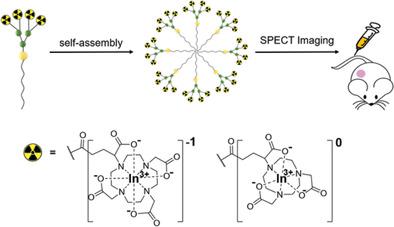Our official English website, www.x-mol.net, welcomes your feedback! (Note: you will need to create a separate account there.)
Surface Charge of Supramolecular Nanosystems for In Vivo Biodistribution: A MicroSPECT/CT Imaging Study.
Small ( IF 13.3 ) Pub Date : 2020-08-14 , DOI: 10.1002/smll.202003290 Ling Ding 1, 2 , Zhenbin Lyu 1, 3 , Beatrice Louis 4, 5 , Aura Tintaru 3 , Erik Laurini 6 , Domenico Marson 6 , Mengjie Zhang 7 , Wanxuan Shao 7 , Yifan Jiang 1 , Ahlem Bouhlel 4, 5 , Laure Balasse 4, 5 , Philippe Garrigue 4, 5 , Eric Mas 8 , Suzanne Giorgio 1 , Juan Iovanna 8 , Yuanyu Huang 7 , Sabrina Pricl 6, 9 , Benjamin Guillet 4, 5 , Ling Peng 1
Small ( IF 13.3 ) Pub Date : 2020-08-14 , DOI: 10.1002/smll.202003290 Ling Ding 1, 2 , Zhenbin Lyu 1, 3 , Beatrice Louis 4, 5 , Aura Tintaru 3 , Erik Laurini 6 , Domenico Marson 6 , Mengjie Zhang 7 , Wanxuan Shao 7 , Yifan Jiang 1 , Ahlem Bouhlel 4, 5 , Laure Balasse 4, 5 , Philippe Garrigue 4, 5 , Eric Mas 8 , Suzanne Giorgio 1 , Juan Iovanna 8 , Yuanyu Huang 7 , Sabrina Pricl 6, 9 , Benjamin Guillet 4, 5 , Ling Peng 1
Affiliation

|
Bioimaging has revolutionized medicine by providing accurate information for disease diagnosis and treatment. Nanotechnology‐based bioimaging is expected to further improve imaging sensitivity and specificity. In this context, supramolecular nanosystems based on self‐assembly of amphiphilic dendrimers for single photon emission computed tomography (SPECT) bioimaging are developed. These dendrimers bear multiple In3+ radionuclides at their terminals as SPECT reporters. By replacing the macrocyclic 1,4,7,10‐tetraazacyclododecane‐1,4,7,10‐tetraacetic acid cage with the smaller 1,4,7‐triazacyclononane‐1,4,7‐triacetic acid scaffold as the In3+ chelator, the corresponding dendrimer exhibits neutral In3+‐complex terminals in place of negatively charged In3+‐complex terminals. This negative‐to‐neutral surface charge alteration completely reverses the zeta‐potential of the nanosystems from negative to positive. As a consequence, the resulting SPECT nanoprobe generates a highly sought‐after biodistribution profile accompanied by a drastically reduced uptake in liver, leading to significantly improved tumor imaging. This finding contrasts with current literature reporting that positively charged nanoparticles have preferential accumulation in the liver. As such, this study provides new perspectives for improving the biodistribution of positively charged nanosystems for biomedical applications.
中文翻译:

用于体内生物分布的超分子纳米系统的表面电荷:MicroSPECT / CT成像研究。
通过提供准确的疾病诊断和治疗信息,生物影像技术已经彻底改变了医学。基于纳米技术的生物成像有望进一步提高成像灵敏度和特异性。在此背景下,开发了基于两亲树状聚合物自组装的超分子纳米系统,用于单光子发射计算机断层扫描(SPECT)生物成像。这些树枝状分子在其末端带有多个In 3+放射性核素,作为SPECT报告分子。通过用较小的1,4,7-三氮杂环壬烷-1,4,7-三乙酸支架代替In 3+取代大环1,4,7,10-四氮杂十二烷-1,4,7,10-四乙酸笼螯合剂,相应的树枝状聚合物表现出中性的In 3+络合物端子,而不是带负电荷的In3+复杂端子。这种从负到中性的表面电荷变化将纳米系统的ζ电势完全从负反转为正。结果,所得的SPECT纳米探针产生了备受追捧的生物分布特征,并伴随着肝脏吸收的急剧减少,从而显着改善了肿瘤成像。这一发现与目前的文献报道相反,该文献报道带正电的纳米粒子在肝脏中具有优先积累。因此,这项研究为改善带正电荷的纳米系统在生物医学应用中的生物分布提供了新的视角。
更新日期:2020-09-18
中文翻译:

用于体内生物分布的超分子纳米系统的表面电荷:MicroSPECT / CT成像研究。
通过提供准确的疾病诊断和治疗信息,生物影像技术已经彻底改变了医学。基于纳米技术的生物成像有望进一步提高成像灵敏度和特异性。在此背景下,开发了基于两亲树状聚合物自组装的超分子纳米系统,用于单光子发射计算机断层扫描(SPECT)生物成像。这些树枝状分子在其末端带有多个In 3+放射性核素,作为SPECT报告分子。通过用较小的1,4,7-三氮杂环壬烷-1,4,7-三乙酸支架代替In 3+取代大环1,4,7,10-四氮杂十二烷-1,4,7,10-四乙酸笼螯合剂,相应的树枝状聚合物表现出中性的In 3+络合物端子,而不是带负电荷的In3+复杂端子。这种从负到中性的表面电荷变化将纳米系统的ζ电势完全从负反转为正。结果,所得的SPECT纳米探针产生了备受追捧的生物分布特征,并伴随着肝脏吸收的急剧减少,从而显着改善了肿瘤成像。这一发现与目前的文献报道相反,该文献报道带正电的纳米粒子在肝脏中具有优先积累。因此,这项研究为改善带正电荷的纳米系统在生物医学应用中的生物分布提供了新的视角。



























 京公网安备 11010802027423号
京公网安备 11010802027423号